George Hoshida Collection
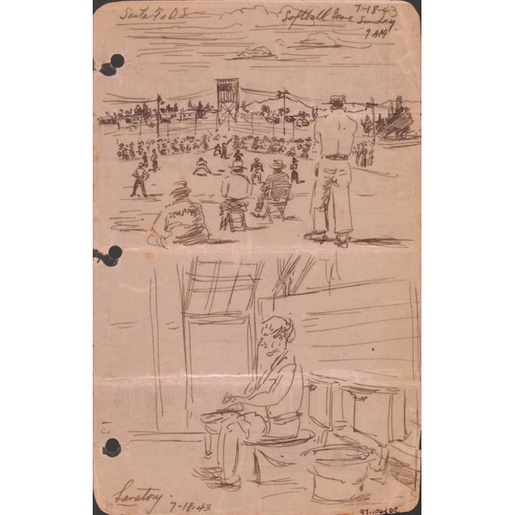
|
||
| Licensing | ||
George Hoshida was born in 1907 in Kumamoto, Japan. He migrated with his family to Hilo, Hawaii when he was four years old, and this is where George spent all of his childhood and adolescent years. He was involved with his Buddhist temple and with Judo, two things that would later cause him to be considered "potentially dangerous." Due to a mixture of World War II, of the bombing of Pearl Harbor and of George's "potentially dangerous" status, he was forcefully removed from his home and family and placed at Kilauea Military Camp in Hawaii. George's journey was extremely difficult, and he had to wait two full years before he could be reunited with his family at the War Relocation Authority concentration camp in Jerome, Arkansas. George was sent from Kilauea Military Camp in Hawaii to the Justice Department camp in Fort Sam Houston, Texas. Next, he went to both the Justice Department camp in Lordsburg and the Justice Department camp in Santa Fe, New Mexico. Throughout his time away from his family, George and his wife, Tamae, wrote letters to each other almost everyday. More importantly, at least for our sake, George kept busy by sketching, drawing and painting pictures of his journey and observations. His pictures give us an idea of what the Justice Department camps were like, and of what the mainland concentration camps were like. This collection includes some of George's art, art that was created during a time of great struggle. Even though his situation was difficult, we are fortunate that George found the courage and strength to continue to document this painful and unjust time in history. To see more of George's artwork, please visit The Japanese American National Museum website. Copyright is held by the Japanese American National Museum. Short-term educational use with limited circulation is permitted. For all other uses, please contact the Hirasaki National Resource Center at the Japanese American National Museum hnrc@janm.org
Slides in this album |
|
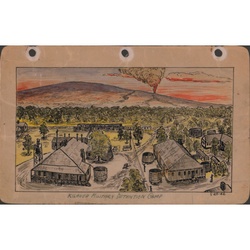
|
George Hoshida, "Kilauea military detention camp, 8-25-42"George was placed here at the Kilauea Military Detention Camp in Hawaii, shortly after the bombing of Pearl Harbor. This is a view of the camp, complete with smoke from the Mount Kilauea volcano in the background. To see pictures of what the Kilauea Military Camp looks like today, 2007, …
George Hoshida, "Kilauea military detention camp, 8-25-42" |

|
George Hoshida, "San Antonio Texas Fort Sam Houston Internment Camp"This painting shows the living situation at Fort Sam Houston, Texas. The men were not put into barracks, but instead lived in tents like the ones shown here.
George Hoshida, "San Antonio Texas Fort Sam Houston Internment Camp" |

|
George Hoshida, "Detention camp tent interior (Tent #46), For Sam Houston, San Antonio, Texas, 6-10-42"If you look beyond the open flap of this tent, you can see a guard tower in the distance.
George Hoshida, "Detention camp tent interior (Tent #46), For Sam Houston, San Antonio, Texas, 6-10-42" |

|
George Hoshida, "Tent #6 - My Bed at Ft. Sam Houston - 6-15-42"Again, the incarcerated Japanese American people at Fort Sam Houston were put into tents instead of buildings, as this picture and title clearly show. The tent sides have been lifted up, so as to show the other tents outside, and George's belongings all fit under his cot.
George Hoshida, "Tent #6 - My Bed at Ft. Sam Houston - 6-15-42" |
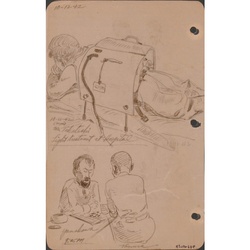
|
George Hoshida, "Mr. Takatashi : light treatment at hospital, 10-12-42 Monday "This one piece of paper shows two different activities that went on at Lordsburg. The top shows a man receiving light treatment at a hospital. The machine has a tag on it, suggesting that it was new, or at least new to the camp. The bottom shows two men playing …
George Hoshida, "Mr. Takatashi : light treatment at hospital, 10-12-42 Monday " |
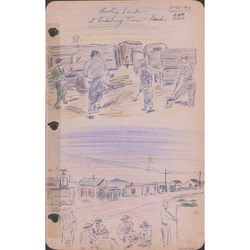
|
George Hoshida, "Shoveling sand at Lordsburg Town back, 3-12-43 9 AM"After being at Fort Sam Houston, George was taken by train to Lordsburg, New Mexico. Here, he shows the men hard at work, and then below he shows the men resting. The people believed that since the war and their situations could not be helped, they might as well endure …
George Hoshida, "Shoveling sand at Lordsburg Town back, 3-12-43 9 AM" |
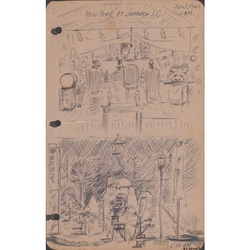
|
George Hoshida, "New year at Lordsburg I.C., Jan. 1, 1943 6 AM"This is a picture of the New Year celebration, or attempted celebration, at Lordsburg during the middle of World War II.
George Hoshida, "New year at Lordsburg I.C., Jan. 1, 1943 6 AM" |
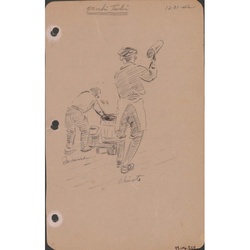
|
George Hoshida, "Mochi tsuki "The Japanese American prisoners tried to keep tradition alive. One such tradition was the celebration of the new year with mochi, "a Japanese rice cake made from glutinous rice" (Wikipedia). Here, George shows two men engaging in "mochitsuki," a traditional pre-new year activity. |
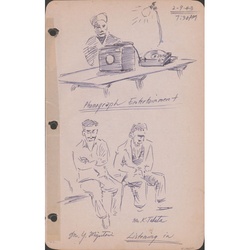
|
George Hoshida, "Phonograph entertainment"This picture shows three men, one on top and two below, listening to the music on the phonograph as a form of entertainment on February 9, 1943. |
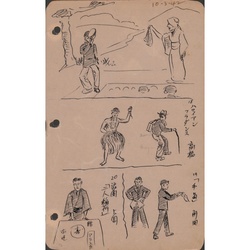
|
George Hoshida, "18 Hawaian fula dansu : Takahashi"This picture embodies the term, "shikata ga nai." This term refers to the attitude held by many of those incarcerated in Lordsburg, that their situations could not be helped, so they must endure. They endured through art, in George's case, or through theatre and performance, like this drawing shows. Although …
George Hoshida, "18 Hawaian fula dansu : Takahashi" |

|
George Hoshida, "Softball game, Sunday 9 AM, 7-18-43"It is unclear why these two pictures were drawn on the same sheet of paper. I assume it is due to George's limited supplies and desire to document all that was happening around him. The top picture shows a softball game, one of the activities that the prisoners involved themselves …
George Hoshida, "Softball game, Sunday 9 AM, 7-18-43" |
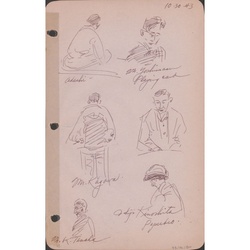
|
George Hoshida, "10-30-43"This sketch was done while George was at Jerome, Arkansas. It is of six different men, five of which have been identified. These men are shown engaged in various activities, such as playing cards, and wearing different types of clothing, such as suits and hats. Please see the original item … |
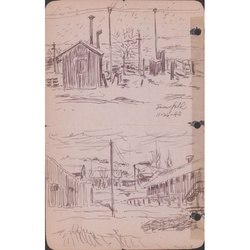
|
George Hoshida, "Snow fall, 11-26-43"George grew up in Hawaii, a place where he probably never saw snow. So, to experience this weather, unprepared, must have been difficult for George. |
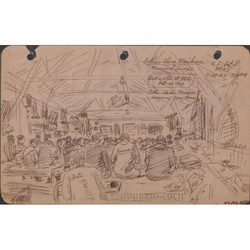
|
George Hoshida "Arthur Akira Morihara memorial service(died in action, Italy, Oct. 23, 1943):SF Det.St. BK-58, 11-28-43-7:30pm"This memorial service took place 35 days after Mr. Morihara had passed away. I wonder whether it took that long to hear news of his passing. The service was held inside barrack 58 at the Santa Fe Justice Department camp, New Mexico. You can even see the beds that people …
George Hoshida "Arthur Akira Morihara memorial service (died in action, Italy, Oct. 23, 1943):SF Det.St. BK-58, 11-28-43-7:30pm" |

|
George Hoshida, "Looking towards lower mess hall, Santa Fe D.S."The top picture here is of the mess hall, which sits between the two rows of barracks. The lower picture is of an outdoor stage, again situated between two rows of barracks. In the background of both pictures are mountains. This suggests seclusion and harsh weather conditions, which we know …
George Hoshida, "Looking towards lower mess hall, Santa Fe D.S." |
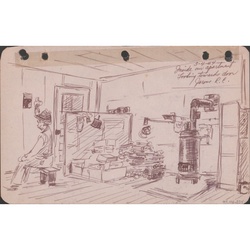
|
George Hoshida, "3-4-44 inside our apartment : looking towards door, Jerome R.C."This is the inside of the Hoshida family barrack at Jerome. The man on the left is apparently looking out into the camp. The rest of the picture shows the room itself, with the door, a screen, a dustpan, a cabinet and a pail. The size and appearance of the …
George Hoshida, "3-4-44 inside our apartment : looking towards door, Jerome R.C." |
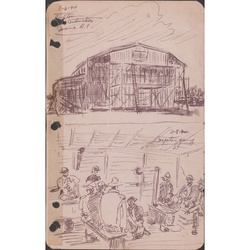
|
George Hoshida, "3-6-44 auditorium construction, Jerome R.C."This picture shows the construction of the auditorium at camp Jerome, and also shows the men who worked on this auditorium. It's wonderful to have this hand-drawn, for you could not capture both of these striking images in one frame of a photograph.
George Hoshida, "3-6-44 auditorium construction, Jerome R.C." |
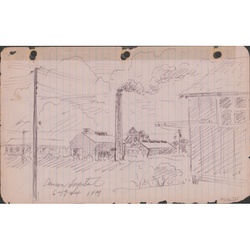
|
George Hoshida, "Denson Hospital, 6-19-44, 1 PM"To show the entirety of the Camp at Jerome, George drew Denson Hospital, which can be seen beyond the billowing smoke stack in this picture.
George Hoshida, "Denson Hospital, 6-19-44, 1 PM" |

|
George Hoshida, "Leaving Camp 2 for Camp 1 to see flower at nursery, 12/5/44, 10 AM"This excursion may have also been a part of the more lenient administration at the Gila River concentration camps. The picture shows a group of people on a bus, probably waiting to go see this flower at the other Gila River camp.
George Hoshida, "Leaving Camp 2 for Camp 1 to see flower at nursery, 12/5/44, 10 AM" |

|
George Hoshida, "Looking at Center, picnic : 3-25-45, 1:15 PM"This picture looks like it was created outside of the Gila River camp, and it probably was. The prisoners there were allowed to go out and have picnics in the desert, as well as shop in Phoenix and other similar activities. The barracks of Butte camp can be seen to …
George Hoshida, "Looking at Center, picnic : 3-25-45, 1:15 PM" |
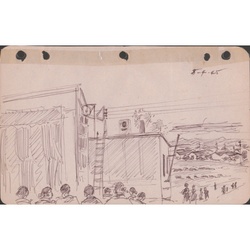
|
George Hoshida, "Gila River camp outdoor theater, Arizona, 5-4-45"George and his family were relocated from Jerome concentration camp to the Butte camp at the Gila River concentration camp in Arizona. Life was a bit easier there, and the guards allowed for a bit more normalcy. This theatre-going experience may have been one of the new activities that they …
George Hoshida, "Gila River camp outdoor theater, Arizona, 5-4-45" |
 eishida
eishida
 UCLA Nikkei Student Union Culture Night 2008
UCLA Nikkei Student Union Culture Night 2008 The Sculpture of Ruth Asawa: Contours in the Air - Audio Tour
The Sculpture of Ruth Asawa: Contours in the Air - Audio Tour Wakatay Restaurant-Peruvian Nikkei Cuisine
Wakatay Restaurant-Peruvian Nikkei Cuisine 2007 Gardena Buddhist Church Obon
2007 Gardena Buddhist Church Obon Frank Kikuchi
Frank Kikuchi Hisako Hibi
Hisako Hibi San Jose Taiko and CAVA - 1st and Central Summer Concerts 2007
San Jose Taiko and CAVA - 1st and Central Summer Concerts 2007 2007 Higashi Honganji Buddhist Temple Obon
2007 Higashi Honganji Buddhist Temple Obon Landscaping America: Beyond the Japanese Garden - Timeline
Landscaping America: Beyond the Japanese Garden - Timeline Jack Iwata Collection
Jack Iwata Collection
 Journal feed
Journal feed
